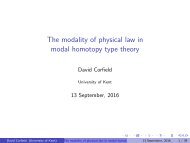TOMBO Ver.2 Manual
TOMBO
TOMBO
You also want an ePaper? Increase the reach of your titles
YUMPU automatically turns print PDFs into web optimized ePapers that Google loves.
2.5 The GW approximation 18<br />
The GW self-energy can be separated into two terms ( Σ GW = Σx + Σ c ). The exchange part<br />
is given by<br />
Σ x (r,r ′ ) = i ∫<br />
2π<br />
dωe iω0+ G(r,r ′ ;ω)ν(r − r ′ ) = −<br />
occ<br />
∑<br />
nk<br />
ψ nk (r)ψ ∗ nk (r)<br />
|r − r ′ |<br />
(2.30)<br />
In equation (2.30), the symbol occ in the sum means that the summation is taken over the<br />
occupied states only. The diagonal matrix elements of this exchange part of the self-energy<br />
become<br />
⟨<br />
n,k<br />
∣ ∣Σx (r,r ′ ) ∣ ∣ n,k<br />
⟩<br />
= −<br />
occ<br />
∑<br />
∑<br />
n ′ q<br />
∑<br />
G<br />
4π<br />
⟨<br />
ΩG 2<br />
∣<br />
n,k∣e i(q+G)·r∣ ⟩⟨<br />
∣ ∣n ′ ,k − q n ′ ∣<br />
k − q∣e −i(q+G)·r′∣ ⟩<br />
∣ ∣n,k<br />
(2.31)<br />
The correlation part, Σ c can be evaluated by using generalized plasmon-pole (GPP)<br />
model [19]. Σ c can also be evaluated by using the full ω integration [20]:<br />
Σ c (r,r ′ ;ω) = i ∫<br />
2π<br />
dω ′ e −iω0+ G(r,r ′ ;ω − ω ′ ) [ W(r,r ′ ;ω ′ ) − ν(r − r ′ ) ] (2.32)<br />
In Equation (2.32), it is difficult to perform the ω ′ integral along the real axis, since W and<br />
G have a strong structure on this axis. In order to avoid this difficulty, Godby et al.[21–24]<br />
restricted the values of ω to small imaginary numbers and changed the contour of the ω ′<br />
integral from real axis to imaginary axis [16]. Then, by analytic continuation, the resulting<br />
Taylor series is used to estimate the matrix elements for real values of ω. Ishii and Ohno et<br />
al. [20, 25] suggested that this intergration method employed by Godby et al. [16] can be<br />
extended rather easily to real number of ω by slightly modifying the contour. The contour<br />
along the real ω ′ axis from −∞ to +∞ for the integral Equation (2.32) can be replaced by<br />
the contour C shown in Fig.2.2.<br />
Here we further use the symmetry W(ω) = W(−ω) to reduce the contour to the positive<br />
real and imaginary parts only. The diagonal matrix elements of the correlation part of the<br />
self-energy become<br />
⟨<br />
n,k<br />
∣ ∣Σc (r,r ′ ;ω) ∣ ∣ n,k<br />
⟩<br />
= ∑<br />
∑<br />
n ′ q<br />
× i<br />
2π<br />
⟨<br />
∑<br />
G,G ′<br />
∫<br />
∣<br />
n,k∣e i(q+G)·r∣ ⟩⟨<br />
∣ ∣n ′ ,k − q n ′ ∣<br />
k − q∣e −i(q+G′ )·r ′∣ ⟩<br />
∣ ∣n,k<br />
dω ′ [ W G,G ′(q,ω ′ ) − (4π/ΩG 2 ]<br />
)δ G,G ′<br />
1<br />
× (<br />
ω + ω ′ +<br />
− ε k−q,n − iδ k−q,n<br />
1<br />
ω − ω ′ − ε k−q,n − iδ k−q,n<br />
)<br />
(2.33)



